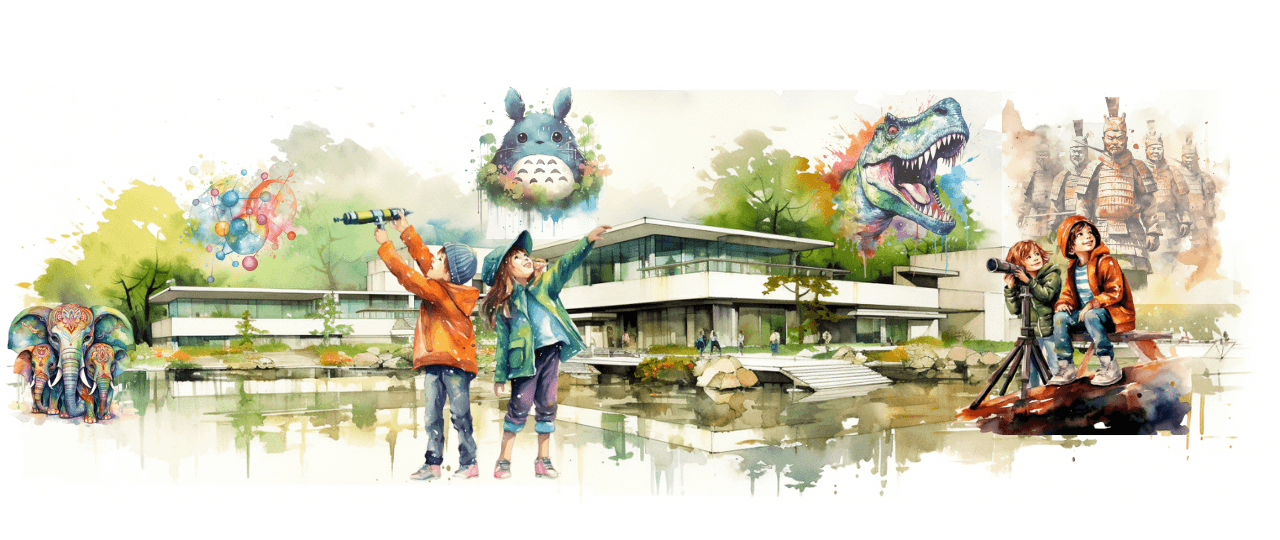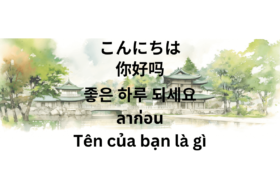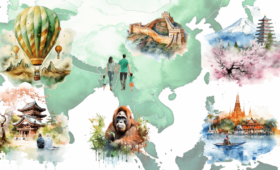Embark on a captivating journey through Asia’s finest museums and interactive exhibits, where history and innovation converge to offer unparalleled experiences. From the ancient relics in the National Museum of China to the cutting-edge technology of Tokyo’s National Museum of Nature and Science, Asia’s museums are treasure troves of cultural wealth. Meanwhile, interactive exhibits like Tokyo’s Trick Eye Museum and the Philippines’ Mind Museum transform learning into an engaging, hands-on adventure. Whether you’re a history buff, art aficionado, or a family seeking educational fun, Asia’s diverse array of museums and interactive exhibits promises to enrich and inspire. Discover these cultural landmarks and experience the perfect blend of learning and entertainment. We have Nature and Science Exploration, an article to help you choose where to go with your kids.
Tokyo Metropolitan Art Museum, Tokyo, Japan
The Tokyo Metropolitan Art Museum, situated in Ueno Park in Tokyo, Japan, is a renowned cultural landmark. Established in 1926, it serves as a hub for artistic expression and appreciation, featuring a wide range of Japanese and international art. The museum has no permanent collection, making it unique as it hosts various traditional and contemporary exhibitions.
When to Visit
The best time to visit the Tokyo Metropolitan Art Museum is on weekdays, as weekends and national holidays are more crowded. The museum’s opening hours are typically from 9:30 AM to 5:30 PM, with extended hours for special exhibitions. It’s closed on Mondays, except when Monday is a national holiday.

Photo source: Tripadvisor.com
What to Expect
Visitors can expect diverse collections that change regularly, ensuring a fresh experience with each visit. Exhibitions often include classical art, modern Japanese art, and international works. The museum also features educational programs, workshops, and lectures, appealing to art enthusiasts and novices.
The experience at the Tokyo Metropolitan Art Museum is characterized by its serene and welcoming atmosphere. The museum’s architectural design complements the art within, offering spacious galleries and a tranquil environment. The museum’s layout is visitor-friendly, allowing for a leisurely exploration of the art exhibits.
Insider Traveler Tips
- Plan: Check the museum’s website for current and upcoming exhibitions to plan your visit accordingly.
- Audio Guides: Available in multiple languages, they offer in-depth insights into the exhibits.
- Ueno Park: Combine your visit with other attractions in Ueno Park, like the Ueno Zoo and the National Museum of Nature and Science.
- Café and Shop: The museum café is a great relaxing spot, offering unique art-related souvenirs.
- Accessibility: The museum is wheelchair accessible and visitor-friendly for those with special needs.
A visit to the Tokyo Metropolitan Art Museum offers a blend of cultural enrichment and artistic inspiration, making it a must-visit for art lovers exploring Tokyo.
If you visit their website, you can view all the past exhibits at the Tokyo Metropolitan Art Museum, as well as the upcoming ones.
National Museum of Nature and Science, Tokyo, Japan
The National Museum of Nature and Science, located in Tokyo’s vibrant Ueno Park, is one of Japan’s preeminent museums dedicated to natural history and science. Established in 1877, this expansive museum offers a comprehensive exploration of the natural world and the history of scientific advancement in Japan and globally. It features a wide range of exhibits that span from the prehistoric era to modern technological innovations.
When to Visit
The museum is typically open from 9:00 AM to 5:00 PM, and it’s closed on Mondays (or the following day if Monday is a national holiday). Visiting on weekdays is recommended to avoid larger crowds, particularly school groups. The museum also tends to be less crowded later in the afternoon.
What You Will See
The museum is divided into two main areas: the Japan Gallery and the Global Gallery.
- Japan Gallery: Focuses on the natural history of the Japanese archipelago, showcasing local flora, fauna, and geological features. Highlights include traditional dioramas and exhibits on Japanese ecosystems.
- Global Gallery: Covers a broad range of topics, including evolution, biodiversity, and the environment. Notable exhibits include dinosaur skeletons, a life-size model of a blue whale, and interactive displays on space and technology.

Photo source: Tripadvisor.com
Visitors can expect an educational and engaging experience. The museum’s exhibits are well-curated and informative, suitable for all ages. Interactive displays, especially in the Global Gallery, make learning about science and nature both fun and immersive. The museum also frequently hosts special exhibitions and events that delve deeper into specific scientific topics.
Travelers Tips
- Plan Your Visit: Check the museum’s website for information on special exhibits and events to make the most of your visit.
- Audio Guides: Available in multiple languages, they enhance the experience with detailed explanations of the exhibits.
- Ueno Park: Consider exploring other attractions in Ueno Park, such as the Tokyo Metropolitan Art Museum or Ueno Zoo.
- Facilities: The museum offers lockers, a gift shop with unique science-themed souvenirs, and a café for refreshments.
- Photography: Photography is allowed in most areas, but be sure to check for any restrictions on specific exhibits.
A visit to the National Museum of Nature and Science is not just a learning experience but also an opportunity to appreciate the wonders of our natural world and the advancements in science that help us understand it.
Ghibli Museum, Mitaka- Japan
The Ghibli Museum, nestled in the serene Inokashira Park in Mitaka, Tokyo, is a magical destination for fans of Studio Ghibli’s acclaimed animated films. Designed by Hayao Miyazaki, the museum is a whimsical and enchanting place that celebrates the art and animation of Studio Ghibli. Its unique design and interactive exhibits make it feel like stepping into a Ghibli film.
Best Time to Visit
The Ghibli Museum is highly popular, and entry is by advance reservation only. Tickets go on sale three months in advance and often sell out quickly. Visiting on weekdays, especially in the morning, usually means fewer crowds. The museum is closed on most Tuesdays and during the New Year holidays.
What to See
- Permanent Exhibitions: These include rooms replicating an animator’s studio, showcasing the creative process behind the films.
- Special Exhibitions: Rotating exhibitions focus on different themes from Ghibli movies.
- Exclusive Short Films: The museum’s theater screens short films created by Studio Ghibli that can only be seen here.
- Rooftop Garden: Features a life-sized robot soldier from “Castle in the Sky.”
- Interactive Spaces: Such as the Catbus room for children.
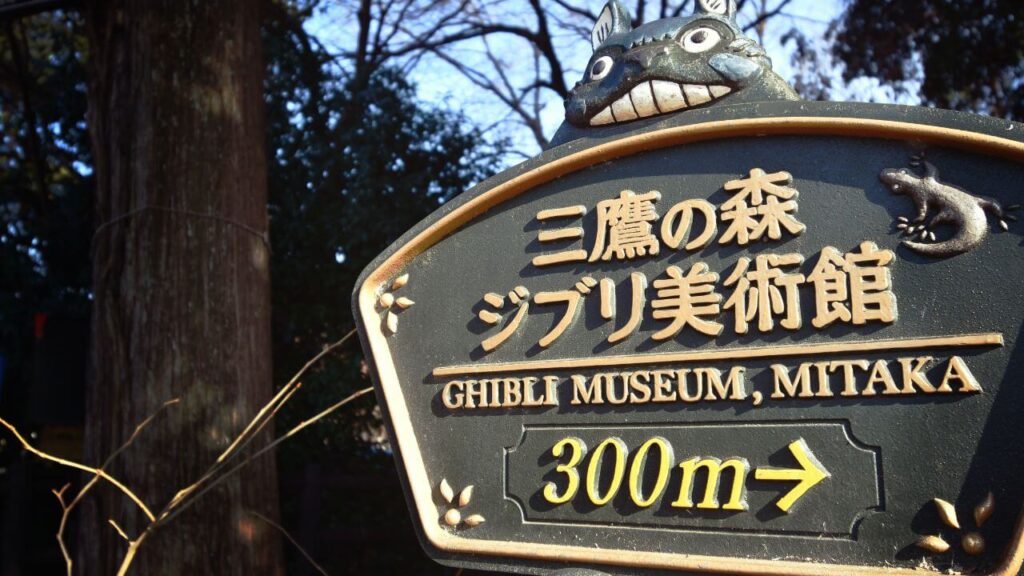
The Ghibli Museum offers a deeply immersive and interactive experience. Each room and exhibit is crafted with great detail, allowing visitors to feel as if they are part of the Ghibli universe. The museum’s architecture itself is a wonder, with hidden nooks and spiral staircases, creating an exploratory adventure.
Traveler Tips
- Tickets: Purchase tickets in advance through the museum’s official website or designated vendors.
- Photography: Photography is not allowed inside the museum to preserve the magical experience, but it’s allowed in the outdoor areas.
- Language Barrier: While most exhibits are in Japanese, the sheer visual storytelling transcends language barriers.
- Duration of Visit: Allocate at least 2-3 hours to enjoy the museum fully.
- No Large Bags: Large bags must be stored in lockers at the museum entrance.
- Refreshments: The Straw Hat Café on the premises offers Ghibli-themed food and drinks.
Visiting the Ghibli Museum is a memorable experience, offering a unique insight into the world of Studio Ghibli and the magic of animation.
National Museum of China, Beijing, China
The National Museum of China, located on the eastern side of Tiananmen Square in Beijing, stands as one of the largest museums in the world. This prestigious institution beautifully melds the history of ancient China with its modern achievements. It was established in 2003 through the merger of the former National Museum of Chinese History and the National Museum of Chinese Revolution. The museum’s extensive collection showcases the rich tapestry of Chinese history, art, and culture over millennia.
Best Time to Visit
The best time to visit the National Museum of China is on weekdays, as weekends and public holidays tend to be very crowded. The museum is open from 9:00 AM to 5:00 PM, with the last entry at 4:00 PM. It’s closed on Mondays, except for national holidays. Early mornings or late afternoons on weekdays are usually less crowded.

What to See
- Ancient China Exhibition: A comprehensive display of artifacts from prehistoric times to the late Qing Dynasty, including ancient bronzes, ceramics, and jades.
- The Road of Rejuvenation: Focusing on modern China, this exhibit showcases the country’s development and achievements.
- Special Exhibitions: The museum frequently hosts temporary exhibitions, often featuring international works and collaborations.
- The Mao Zedong and Deng Xiaoping Exhibit: Highlighting the significant contributions of these leaders in China’s modern history.
The museum provides an insightful journey through China’s long and storied past. The exhibits are not only historically informative but also artistically impressive. The scale of the museum is vast, so it’s easy to spend several hours exploring the collections. English descriptions are available for most exhibits, making it accessible to international visitors.
Travel Tips
- Plan Your Visit: Check the museum’s website for current and upcoming exhibitions and any visitor notices.
- Free Entry: Admission to the museum is free, but you need to show a valid ID to get a ticket.
- Security Check: Be prepared for a security check at the entrance.
- Audio Guide: Consider renting an audio guide to understand the exhibits better.
- Wear Comfortable Shoes: The museum is large, and there’s a lot of walking involved.
- Photography: Photography is allowed, but flash and tripods are prohibited.
- Food and Drink: Eating and drinking inside the museum are not allowed. However, there are dining options available nearby.
Visiting the National Museum of China is not just an educational experience but a journey through the vast expanse of Chinese history and culture, making it a must-visit for anyone interested in understanding China’s past and present.
Emperor Qinshihuang’s Mausoleum Site Museum
Emperor Qinshihuang’s Mausoleum Site Museum, more famously known as the Terracotta Army Museum, is in Lintong District, Xi’an, Shaanxi province of China. This UNESCO World Heritage site is one of the most significant archaeological discoveries of the 20th century. The museum covers the mausoleum of Qin Shi Huang, the first Emperor of China, and is renowned for the thousands of life-sized terracotta soldiers, horses, and chariots buried to guard the emperor in his afterlife.
Best Time to Visit
The ideal time to visit is spring (March to May) and autumn (September to November) when the weather is pleasant and mild. The museum tends to be less crowded during weekdays, especially if you visit early in the morning. It’s open year-round, including holidays.
What to See
- The Terracotta Army: The main attraction is the three pits containing the terracotta army, each showcasing the soldiers in battle formation.
- The Bronze Chariots: Two life-sized bronze chariots and horses, exquisitely detailed and well-preserved.
- Exhibition Halls: Display artifacts and information about the Qin Dynasty and the construction of the mausoleum.
- The Mausoleum: While the emperor’s burial mound has not been excavated, visitors can view the mound from a distance.
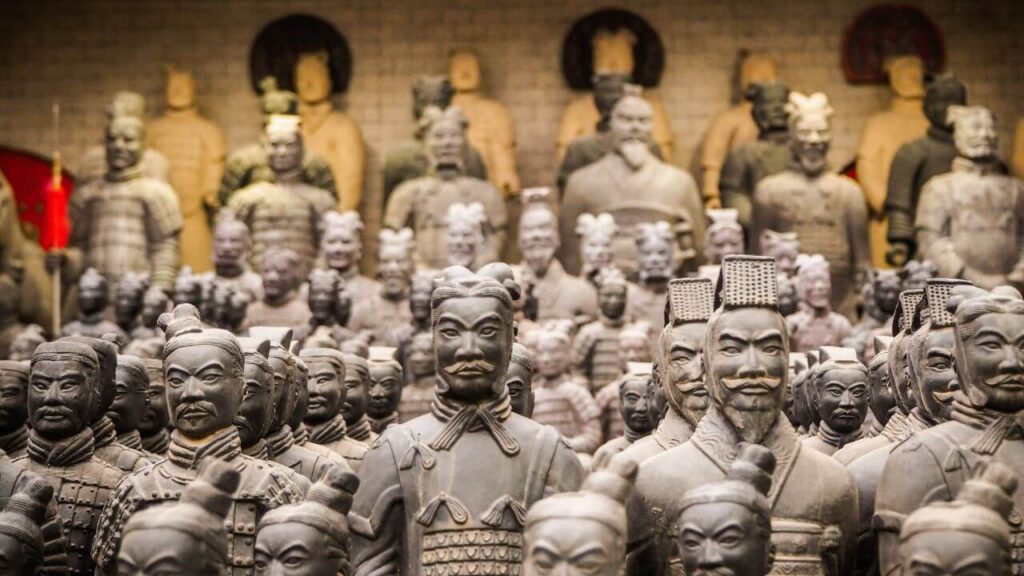
In Emperor Qinshihuang’s Mausoleum Site Museum, you will experience a sense of awe at the sheer scale and historical significance of the site. The museum provides a unique window into ancient Chinese art and military history. The intricacy of the terracotta figures, each with distinct facial features and expressions, is particularly striking. The site is vast, so be prepared for a lot of walking and visual exploration.
Insider Traveler Tips
- Purchase Tickets in Advance, Especially during peak seasons, to avoid long waiting lines.
- Hire a Guide: For a more in-depth understanding of the history and details of the site.
- Photography: Photography is allowed, but flash is prohibited to protect the artifacts.
- Wear Comfortable Shoes: The museum area is large and involves a significant amount of walking.
- Avoid Scams: Be cautious of vendors outside selling “souvenirs” that they claim are real artifacts.
- Transportation: Consider using public transport or a taxi to get to the museum, as it’s located about an hour’s drive from the city center of Xi’an.
Visiting Emperor Qinshihuang’s Mausoleum Site Museum offers a profound glimpse into China’s ancient past and the grandeur of its first emperor. It’s a must-visit for anyone interested in history and archaeology.
Tianjin Natural History Museum, Tianjin, China
The Tianjin Natural History Museum, situated in Tianjin, a major port city in northeastern China, stands as one of the country’s oldest and largest museums of natural history. This museum, renowned for its extensive collection and impressive exhibits, provides a comprehensive overview of the natural world from prehistoric times to the present. Its modern architecture and interactive displays make it a popular destination for both locals and tourists.
Best Time to Visit
The museum is generally less crowded during weekday mornings, making it an ideal time for a visit. It’s open from Tuesday to Sunday, typically from 9:00 AM to 4:30 PM, and is closed on Mondays. Visiting during off-peak hours helps avoid large school groups and offers a more tranquil experience.
What to Expect and See
- Dinosaur Exhibits: The museum is particularly famous for its collection of dinosaur fossils and reconstructions, including some unique species found in China.
- Marine Life Displays: Features a variety of marine fossils and models, providing insights into the aquatic life that once inhabited the region.
- Wildlife Exhibits: Showcases a range of taxidermy specimens, from local wildlife to exotic animals worldwide.
- Botanical and Geological Exhibits: Includes a diverse collection of plant specimens and geological displays illustrating the earth’s mineral wealth.
- Interactive Exhibits: Many displays are interactive, particularly appealing to younger visitors.
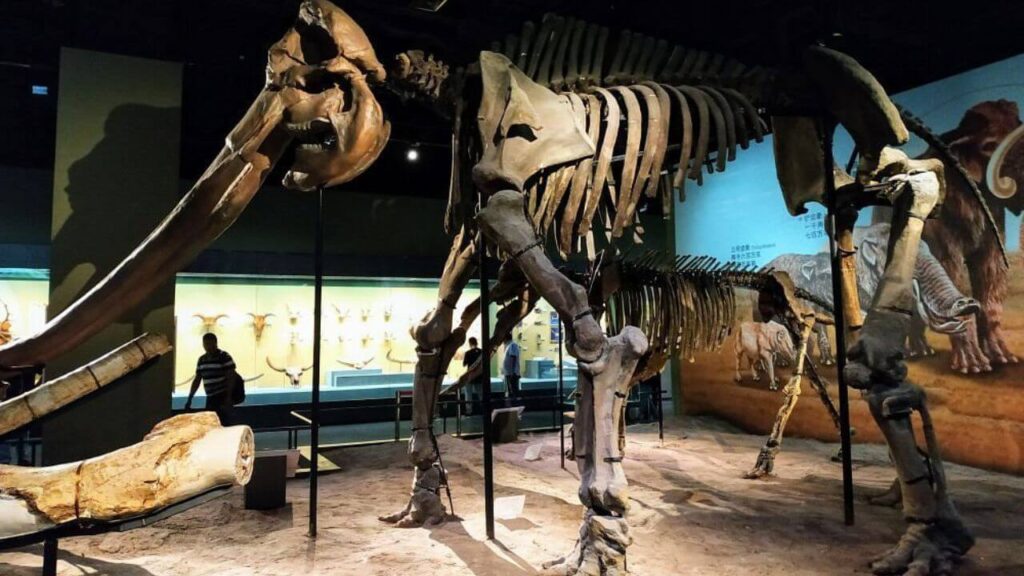
Photo source: Tripadvisor.com
Visitors to the Tianjin Natural History Museum can expect an educational journey through time, with well-curated, informative, and engaging exhibits. The museum’s spacious layout and modern design provide an enjoyable and comfortable visit. It’s an ideal destination for families, science enthusiasts, or anyone interested in learning about natural history.
Traveler Tips
- Plan Your Visit: Check the museum’s website for any special exhibitions or events.
- Photography: Photography is generally allowed, but flash photography may be restricted in certain areas.
- Comfortable Footwear: Be prepared for a fair amount of walking, as the museum covers a large area.
- Language Barrier: While some information is available in English, carrying a translation app may enhance your experience if you don’t speak Mandarin.
- Nearby Attractions: Tianjin offers several other attractions, so consider combining your museum visit with other sightseeing activities in the city.
A visit to the Tianjin Natural History Museum is a fun and immersive way to explore the wonders of the natural world.
National Palace Museum, Taipei, Taiwan
The National Palace Museum in Taipei, Taiwan, is a treasure trove of Chinese imperial art and culture. It houses one of the largest collections of ancient Chinese artifacts and artworks in the world, many of which were moved from the Forbidden City in Beijing during the Chinese Civil War. The collection spans nearly 8,000 years of Chinese history, offering a deep insight into China’s rich cultural heritage.
Best Time to Visit the National Palace Museum
The museum tends to be busiest on weekends and public holidays. To avoid crowds, consider visiting on a weekday, preferably right when the museum opens at 8:30 AM or later in the afternoon after 3:00 PM. The museum is open year-round, including holidays.
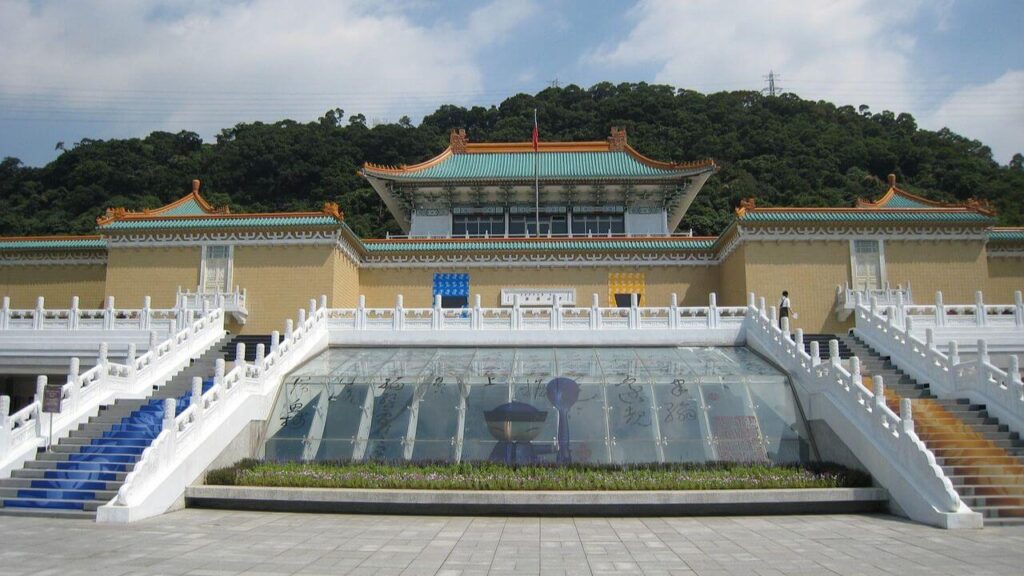
What to See and Expect
- Jadeite Cabbage and Meat-Shaped Stone: Two of the museum’s most famous pieces, renowned for their intricate craftsmanship and lifelike appearance.
- Ancient Chinese Artifacts: Includes calligraphy, paintings, ceramics, bronzes, and more, representing various dynasties and periods of Chinese history.
- Rotating Exhibits: Due to the vastness of the collection, many items are rotated in and out of display, offering something new on each visit.
- Rare Books and Documents: A collection of historical documents and rare books provides an insight into the scholarly and literary traditions of ancient China.
Visitors to the National Palace Museum can expect an immersive journey through Chinese history and art. The museum’s well-curated exhibits, complete with English descriptions, make it accessible to international visitors. The serene and elegant atmosphere of the museum provides a reflective space to appreciate the artifacts.
Traveler Tips
- Ticket Purchase: Tickets can be purchased on-site or online. Consider buying in advance during peak tourist seasons.
- Audio Guides: Available in multiple languages, they offer comprehensive insights into the exhibits.
- Dress Comfortably: Expect to do a lot of walking through the museum’s expansive halls.
- Photography: While photography is allowed in most areas, flash and tripods are prohibited. Some special exhibits may not allow photography.
- Refreshments: The museum houses a restaurant and a tea room, offering traditional Chinese cuisine and a relaxing environment.
- Gift Shop: Visit the museum’s gift shop for unique souvenirs, books, and replicas of the museum’s artifacts.
National Museum of Korea- Seoul, South Korea
The National Museum of Korea, located in Seoul, is the largest and most comprehensive museum in South Korea, showcasing the country’s rich history and cultural heritage. It houses a vast collection of artifacts from prehistoric times to the modern era, making it a key destination for anyone interested in Korean history and art.
Best Time to Visit
The museum is less crowded during weekdays, especially in the morning. It’s open from 10:00 AM to 6:00 PM on most days, with extended hours until 9:00 PM on Wednesdays and Saturdays. The museum is closed on Mondays. Visiting outside of school holiday periods and weekends is recommended for a more peaceful experience.
What to See and Expect
- Prehistoric and Ancient History Galleries: These exhibits feature artifacts from Korea’s early history, including beautiful celadon ceramics and intricate metalwork.
- Calligraphy and Painting Galleries: Showcasing the evolution of Korean calligraphy and painting, with pieces dating back to various dynasties.
- Sculpture and Crafts Gallery: Displays a range of traditional Korean crafts, sculptures, and Buddhist art.
- Ten Story Pagoda and Gold Crown: Notable artifacts include the elegant Ten Story Pagoda from Gyeongcheonsa Temple and the exquisite Silla-era gold crown.
- Children’s Museum: Designed for younger visitors, offering interactive exhibits about Korean culture and history.
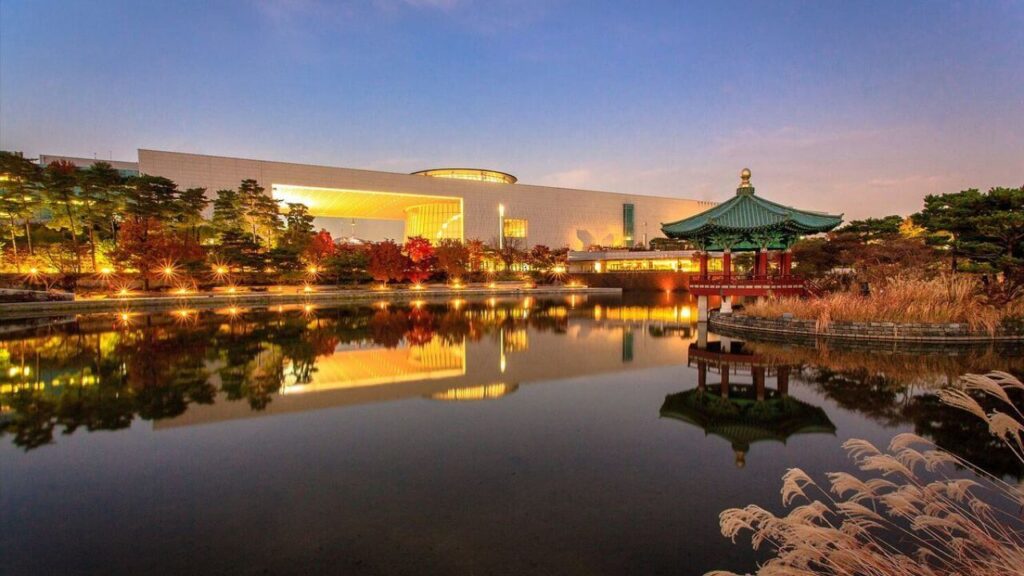
Visitors can expect a well-organized and informative experience, with exhibits clearly labeled in both Korean and English. The museum’s architecture is as impressive as its collection, offering a modern and spacious environment. Interactive elements and multimedia displays make history come alive, appealing to both adults and children.
Traveler Tips
- Free Admission: General admission to the museum is free, although some special exhibitions may require a ticket.
- Audio Guide: Available for rent, providing detailed information about the exhibits in multiple languages.
- Comfortable Shoes: The museum is vast, so wear comfortable shoes as there is a lot of ground to cover.
- Museum Café and Restaurant: Offering various food options, perfect for a break during your visit.
- Museum Shop: A great place to find unique souvenirs and gifts about Korean culture and history.
- Photography: Photography is allowed in most areas, but check for restrictions in special exhibitions.
A visit to the National Museum of Korea is a journey through the rich tapestry of Korean history and culture, offering a deep understanding of the country’s artistic and historical achievements.
The Mind Museum, Taguig, Philippines
The Mind Museum, located in Bonifacio Global City, Taguig, Philippines, is a world-class science museum offering a contemporary learning approach. Designed to be a hands-on, interactive experience, the museum aims to foster public understanding of science in an engaging and enjoyable way. With over 250 interactive exhibits, it covers various scientific concepts and phenomena, making science accessible and fun for all ages.
Best Time to Visit
The museum is generally less crowded on weekdays, especially in the morning. It operates in two shifts – the morning shift and the afternoon shift – and is closed on Mondays. Visiting during the morning shift tends to offer a quieter experience, as school groups usually visit in the afternoon.
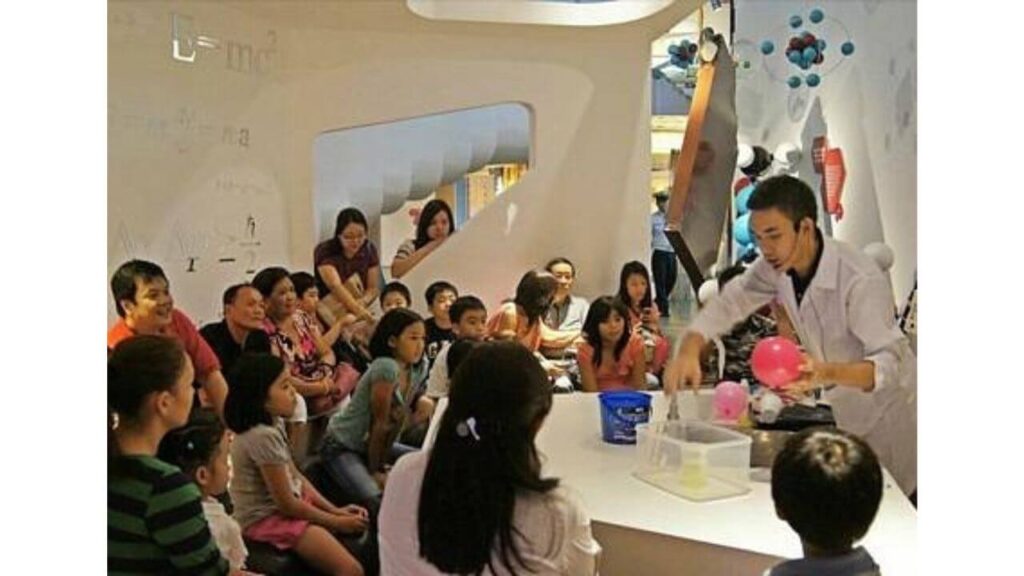
Photo source: Tripadvisor.com
What to See and Expect
- Five Main Galleries: The museum is divided into five main galleries, each focusing on different scientific themes: Atom, Earth, Life, Universe, and Technology.
- Interactive Exhibits: The exhibits are highly interactive, encouraging hands-on learning. They include simulations, games, and experiments to engage visitors of all ages.
- The Atom Gallery: Explore the building blocks of matter with exhibits on atoms, molecules, and the elements.
- The Earth Gallery: Features a life-size T-Rex skeleton and exhibits on geology, meteorology, and paleontology.
- The Universe Gallery: Delve into space exploration and astronomy with a planetarium and space exhibits.
- The Life Gallery: Learn about biology, ecosystems, and the human body through interactive displays.
- The Technology Gallery: Focuses on modern technology, robotics, and the future of innovation.
Visitors to The Mind Museum can expect an immersive and educational experience. The museum’s modern design and state-of-the-art exhibits make learning about science an adventure. It’s particularly appealing to children and teens, but adults will find plenty to engage with as well.
Traveler Tips
- Ticket Purchase: Tickets can be purchased online or on-site, but booking in advance is recommended, especially during peak times.
- Dress Comfortably: Wear comfortable shoes, as there is a lot of walking and standing involved.
- Time Your Visit: Allow at least 2-3 hours to enjoy and interact with the exhibits fully.
- Mind Museum App: Consider downloading The Mind Museum app for a more interactive experience.
- No Food or Drinks: Food and drinks are not allowed inside the exhibit areas.
- Photography: Photography is allowed, so bring a camera to capture the fun moments.
The Mind Museum offers an enriching and enjoyable way to learn about science, making it a must-visit for families and anyone with a curious mind.
Ghost Museum Penang, George Town, Malaysia
The Ghost Museum in Penang, Malaysia, offers a unique and spooky experience unlike typical museums. Located in George Town, this museum is dedicated to all things supernatural and eerie. It’s a popular tourist attraction that delves into the world of ghosts, spirits, and paranormal entities from various cultures and folklore, particularly focusing on Malaysian and Asian ghost stories.
Best Time to Visit
The Ghost Museum is generally less crowded on weekdays. It’s open every day, including weekends and public holidays, usually from 10:00 AM to 7:00 PM. Visiting during the evening can add an extra layer of spookiness to the experience.
What to See and Expect
- Cultural Ghost Exhibits: The museum features various sections dedicated to ghosts and spirits from Malaysian, Chinese, Japanese, Egyptian, and other cultures.
- Interactive Displays: Visitors can interact with some of the exhibits, which include lifelike models and setups of famous ghostly figures and scenes.
- Photography Opportunities: The museum is designed with numerous photo opportunities in mind, allowing visitors to take pictures of the eerie exhibits.
- Educational Aspect: While the primary focus is on entertainment, the museum also provides educational insights into the folklore and myths associated with each ghost and spirit.
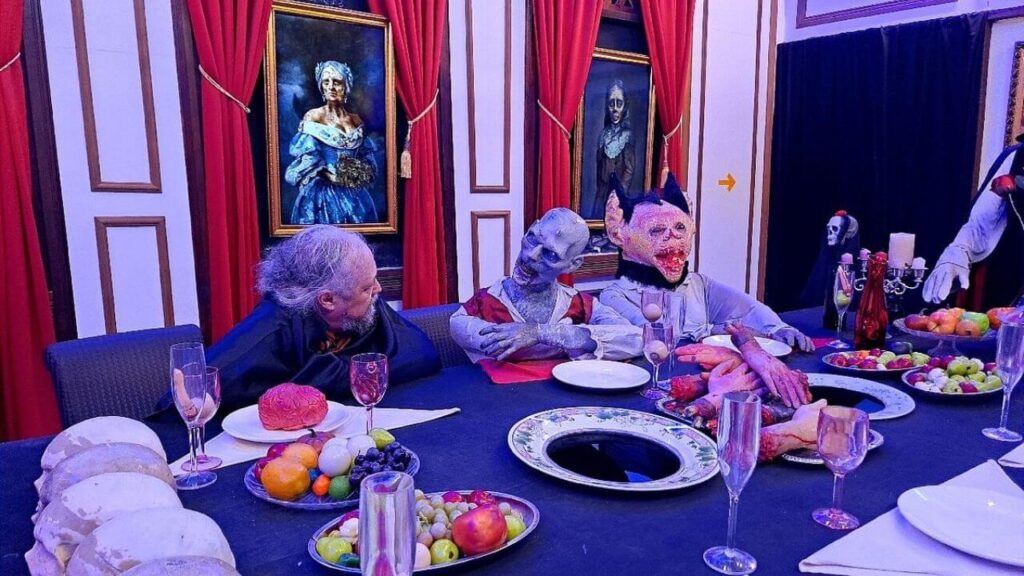
Photo from: Tripadvisor.com
Visitors to the Ghost Museum can expect a fun and slightly spooky experience. It’s an entertaining visit for families and groups of friends. The museum is more quirky than frightening, making it suitable for a wide range of ages, though some younger children might find it scary.
Traveler Tips
- Dress-Up Opportunities: The museum provides costumes and props for visitors to dress up and fully immerse themselves in the spooky atmosphere.
- Not Too Scary: The museum is designed to be more fun and educational than terrifying, making it a good choice for those who enjoy a light-hearted approach to the supernatural.
- Accessibility: The museum is located in the heart of George Town, making it easily accessible by public transport or on foot from nearby attractions.
- Group Visits: It’s a great place for groups, as many exhibits are interactive and fun to experience with others.
- Stay Hydrated: Penang can be hot and humid, so bring water to stay hydrated during your visit.
The Ghost Museum in Penang provides a unique, entertaining, and slightly spooky experience, offering a glimpse into various cultures’ supernatural beliefs and folklore.
Erawan Museum, Thailand
The Erawan Museum in Samut Prakan, just outside Bangkok, Thailand, is a unique and visually stunning museum known for its giant three-headed elephant art sculpture. This museum is a wonder of art and architecture and a spiritual and cultural symbol, blending Hindu and Buddhist motifs and Thai craftsmanship. The three-headed elephant, Airavata, stands atop an equally impressive pedestal building, making the museum a landmark and a work of art.
Best Time to Visit
The best time to visit the Erawan Museum is during the weekdays to avoid crowds. The museum is open daily from 9:00 AM to 7:00 PM. Visiting early in the morning or later in the afternoon can also help avoid the heat and the larger tour groups that often come midday.
What to See and Expect
- The Three-Headed Elephant Statue: This massive bronze sculpture, weighing 250 tons and standing 29 meters high, is an architectural marvel and a symbol of the universe in Hindu cosmology.
- First Floor – Underworld: The museum’s lower level represents the underworld and features a collection of Chinese vases and other antiquities.
- Second Floor – Earth: This level symbolizes the human realm, displaying many religious and cultural artifacts, including Buddha statues and intricate wood carvings.
- Third Floor – Heaven: The top floor, inside the belly of the elephant, represents heaven. It’s adorned with beautiful stained glass and contains a small shrine.
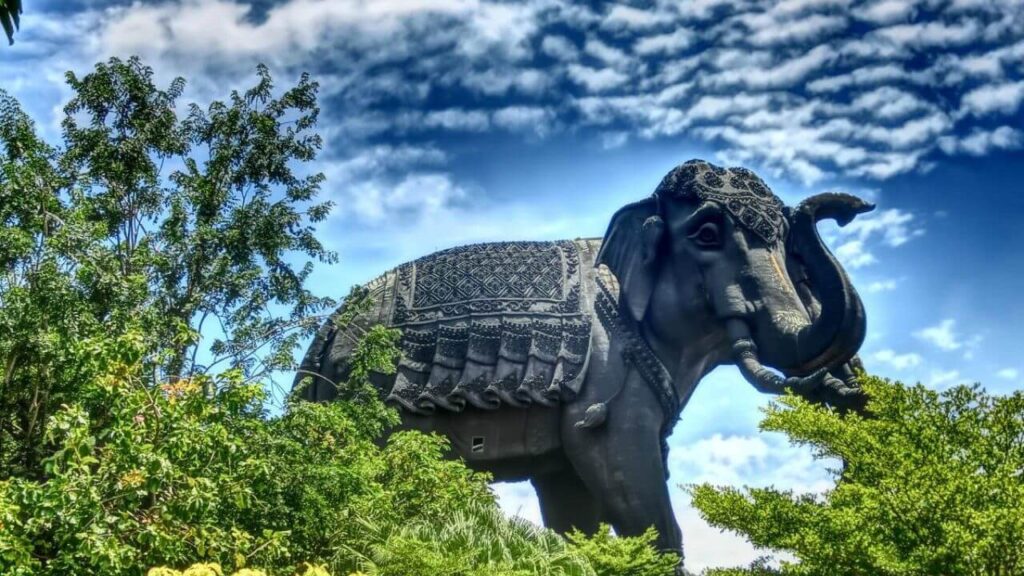
Photo source: Tripadvisor.com
Visiting the Erawan Museum offers a unique blend of spiritual, artistic, and cultural experiences. The museum’s exquisite interior and exterior are a testament to Thai creativity and craftsmanship. The peaceful atmosphere of the museum, combined with the impressive collection of art and artifacts, makes for a memorable visit.
Traveler Tips
- Dress Respectfully: As the museum has a spiritual significance, it’s important to dress modestly out of respect for local customs.
- Photography: Photography is allowed, but be mindful of restrictions in certain areas, especially around sacred objects.
- Guided Tours: To better understand the museum’s artifacts and symbolism, consider joining a guided tour.
- Accessibility: The museum is accessible by taxi or via the BTS Skytrain and a short bus or taxi ride from the nearest station.
- Souvenir Shop: The museum has a gift shop where you can find unique souvenirs and traditional Thai crafts.
The Erawan Museum offers a distinctive and enchanting experience, combining art, architecture, spirituality, and Thai culture in a way that is both educational and awe-inspiring.
Bangkok National Museum, Bangkok, Thailand
The Bangkok National Museum, located in the heart of Bangkok near the Grand Palace, is the largest in Southeast Asia. Established in the late 19th century, it is a primary Thai art and cultural heritage repository. The museum provides comprehensive insight into Thailand’s history and culture, from prehistoric times to modern times. It’s housed in a beautiful historic building, itself a part of the nation’s history.
Best Time to Visit
The museum is usually less crowded during weekdays. It’s open from Wednesday to Sunday, from 9:00 AM to 4:00 PM, and closed on Mondays and Tuesdays. Visiting in the morning allows you to explore the museum in cooler temperatures and with fewer crowds.
What to See and Expect
- Main Gallery: Houses a vast collection of Thai artifacts, including sculptures, ceramics, and textiles, dating back to the Neolithic period.
- Thai History Gallery: Offers a chronological journey through Thai history, showcasing significant archaeological and historical findings.
- Decorative Arts and Ethnological Collection: Displays traditional Thai crafts, including woodcarving, weaving, and regional costumes.
- Buddhist Art Collection: A stunning collection of Thai Buddhist art, including sculptures and images from various periods.
- Royal Funeral Chariots Hall: Features ornate chariots and palanquins used in royal funerals, displaying exquisite craftsmanship.
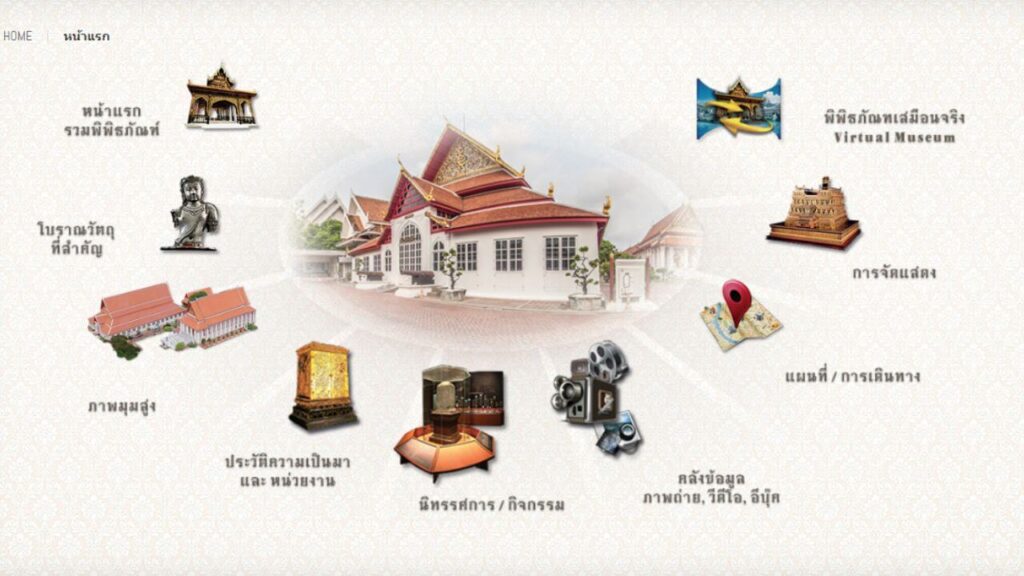
Photo source: Printscreen from their website
Visitors to the Bangkok National Museum will experience a deep dive into Thai culture and history. The museum’s extensive collection is well-organized and informatively labeled, often with English descriptions. The setting in the historic building adds to the atmosphere, making a visit here both educational and visually appealing.
Traveler Tips
- Guided Tours: Free guided tours in English are often available, offering valuable insights into the exhibits.
- Dress Code: Dress respectfully, as the museum is close to the Grand Palace and Wat Phra Kaew, which are sacred sites.
- Photography: Photography is allowed in most areas, but flash photography and tripods may be restricted.
- Plan Your Visit: Given the museum’s size, plan to spend several hours to appreciate the exhibits fully.
- Stay Hydrated: Bangkok can be hot and humid, so bring water to stay hydrated during your visit.
- Accessibility: The museum is accessible by public transport, including buses and riverboats.
The Bangkok National Museum offers a fascinating glimpse into Thailand’s rich cultural tapestry, making it a must-visit for anyone interested in exploring the depth and diversity of Thai history and art.
Exploring Asia’s best museums and interactive exhibits offers an unparalleled journey through a rich tapestry of culture, history, and innovation. From the awe-inspiring ancient artifacts in China’s National Museum to the cutting-edge, hands-on experiences at Tokyo’s National Museum of Nature and Science, each visit promises a unique blend of education and entertainment. Whether immersing yourself in the interactive art of the Trick Eye Museum in South Korea or unraveling history at the Bangkok National Museum, Asia’s diverse range of museums and exhibitions caters to all interests, ensuring that every adventure is enlightening and unforgettable.

